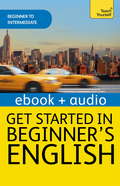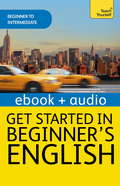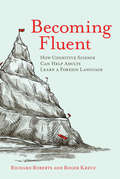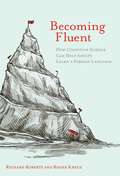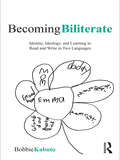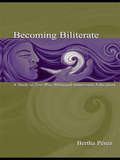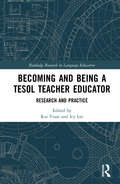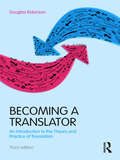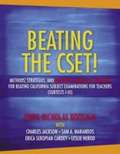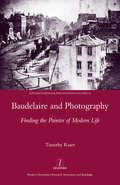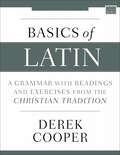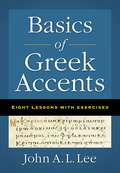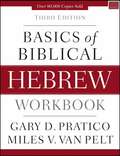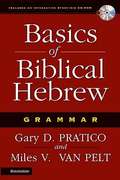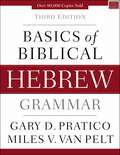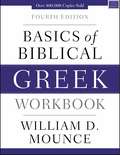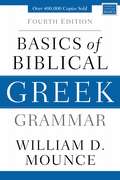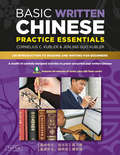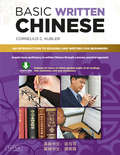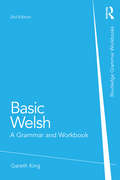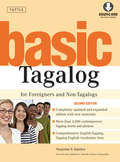- Table View
- List View
Beginner's English: Enhanced Edition (TY English as a Foreign Language)
by Cindy CheethamDo you want a solid foundation to your English studies?If you are looking for a solid foundation to your language studies for school, work or travel, this engaging course will get you speaking, writing, reading and understanding English in no time. Through authentic conversations, clear language presentations, and extensive practice and review, you will learn the English you need to communicate naturally in everyday situations - from booking a hotel room to talking about friends and family.What will I learn?The course focuses on American English but offers British alternatives. Basic English is slowly and carefully introduced to ensure you progress confidently through the course and build up a foundation to allow you to feel confident in everyday situations and move to the next level of your learning. It teaches grammar, vocabulary and listening, reading, writing, speaking and pronunciation skills. By the end of the course you will reach a solid Novice High proficiency level of ACTFL (The American Council for the Teaching of Foreign Languages) and A2 Beginner level of the CEFR (Common European Framework of Reference for Languages) guidelines. Is this course for me?Get Started in English is for absolute and false beginners of English. Clear and simple explanations make the course appropriate and accessible to anyone learning English. There are extensive illustrations to support the learner working on his or her own. This course is also ideal to use with one-to-one tutoring and as a classroom course.What do I get? This enhanced eBook has a learner-centred approach that incorporates the following features:- 10 units of learning content - covering everyday topics from booking a hotel room to talking about friends and family- Discovery Method - figure out rules and patterns yourself to make the language stick- Outcomes-based learning - focus your studies with clear aims- Vocabulary building - thematic lists and activities to help you learn vocabulary quickly- Test yourself - see and track your own progress- Native speaker audio - integrated within the eBook- Free, downloadable audio transcripts and vocabulary and language reference listsWhere do I go next?If you want to advance your English, our Complete English as a Foreign Language course (9781473601581) will take you to an intermediate level of English.If you want to practice your speaking and listening skills, Get Talking and Keep Talking English (9781444193152) is the perfect audio course. It is available in English, French, Spanish, Italian and Portuguese instruction.**If you are looking for a British English course, you can try Get Started in British English (9781473612143).Rely on Teach Yourself, trusted by language learners for over 75 years.
Beginner's English: Enhanced Edition (TY English as a Foreign Language)
by Cindy CheethamDo you want a solid foundation to your English studies?If you are looking for a solid foundation to your language studies for school, work or travel, this engaging course will get you speaking, writing, reading and understanding English in no time. Through authentic conversations, clear language presentations, and extensive practice and review, you will learn the English you need to communicate naturally in everyday situations - from booking a hotel room to talking about friends and family.What will I learn?The course focuses on American English but offers British alternatives. Basic English is slowly and carefully introduced to ensure you progress confidently through the course and build up a foundation to allow you to feel confident in everyday situations and move to the next level of your learning. It teaches grammar, vocabulary and listening, reading, writing, speaking and pronunciation skills. By the end of the course you will reach a solid Novice High proficiency level of ACTFL (The American Council for the Teaching of Foreign Languages) and A2 Beginner level of the CEFR (Common European Framework of Reference for Languages) guidelines. Is this course for me?Get Started in English is for absolute and false beginners of English. Clear and simple explanations make the course appropriate and accessible to anyone learning English. There are extensive illustrations to support the learner working on his or her own. This course is also ideal to use with one-to-one tutoring and as a classroom course.What do I get? This enhanced eBook has a learner-centred approach that incorporates the following features:- 10 units of learning content - covering everyday topics from booking a hotel room to talking about friends and family- Discovery Method - figure out rules and patterns yourself to make the language stick- Outcomes-based learning - focus your studies with clear aims- Vocabulary building - thematic lists and activities to help you learn vocabulary quickly- Test yourself - see and track your own progress- Native speaker audio - integrated within the eBook- Free, downloadable audio transcripts and vocabulary and language reference listsWhere do I go next?If you want to advance your English, our Complete English as a Foreign Language course (9781473601581) will take you to an intermediate level of English.If you want to practice your speaking and listening skills, Get Talking and Keep Talking English (9781444193152) is the perfect audio course. It is available in English, French, Spanish, Italian and Portuguese instruction.**If you are looking for a British English course, you can try Get Started in British English (9781473612143).Rely on Teach Yourself, trusted by language learners for over 75 years.
Becoming Fluent: How Cognitive Science Can Help Adults Learn a Foreign Language (The\mit Press Ser.)
by Richard Roberts Roger KreuzHow adult learners can draw upon skills and knowledge honed over a lifetime to master a foreign language.Adults who want to learn a foreign language are often discouraged because they believe they cannot acquire a language as easily as children. Once they begin to learn a language, adults may be further discouraged when they find the methods used to teach children don't seem to work for them. What is an adult language learner to do? In this book, Richard Roberts and Roger Kreuz draw on insights from psychology and cognitive science to show that adults can master a foreign language if they bring to bear the skills and knowledge they have honed over a lifetime. Adults shouldn't try to learn as children do; they should learn like adults.Roberts and Kreuz report evidence that adults can learn new languages even more easily than children. Children appear to have only two advantages over adults in learning a language: they acquire a native accent more easily, and they do not suffer from self-defeating anxiety about learning a language. Adults, on the other hand, have the greater advantages—gained from experience—of an understanding of their own mental processes and knowing how to use language to do things. Adults have an especially advantageous grasp of pragmatics, the social use of language, and Roberts and Kreuz show how to leverage this metalinguistic ability in learning a new language.Learning a language takes effort. But if adult learners apply the tools acquired over a lifetime, it can be enjoyable and rewarding.
Becoming Fluent
by Richard M. Roberts Roger J. KreuzAdults who want to learn a foreign language are often discouraged because they believe they cannot acquire a language as easily as children. Once they begin to learn a language, adults may be further discouraged when they find the methods used to teach children don't seem to work for them. What is an adult language learner to do? In this book, Richard Roberts and Roger Kreuz draw on insights from psychology and cognitive science to show that adults can master a foreign language if they bring to bear the skills and knowledge they have honed over a lifetime. Adults shouldn't try to learn as children do; they should learn like adults.Roberts and Kreuz report evidence that adults can learn new languages even more easily than children. Children appear to have only two advantages over adults in learning a language: they acquire a native accent more easily, and they do not suffer from self-defeating anxiety about learning a language. Adults, on the other hand, have the greater advantages -- gained from experience -- of an understanding of their own mental processes and knowing how to use language to do things. Adults have an especially advantageous grasp of pragmatics, the social use of language, and Roberts and Kreuz show how to leverage this metalinguistic ability in learning a new language.Learning a language takes effort. But if adult learners apply the tools acquired over a lifetime, it can be enjoyable and rewarding.
Becoming Biliterate: Identity, Ideology, and Learning to Read and Write in Two Languages
by Bobbie KabutoThrough the real-life context of one child learning to be bilingual and biliterate, this book raises questions and provides a context for pre-service and practicing teachers to understand and reflect on how children learn to read and write in multiple languages. Highlighting the social and cognitive advantages of biliteracy, its purpose is to help teachers better understand the complexity by which young children become biliterate as they actively construct meaning and work through tensions resulting from their everyday life circumstances. Perspectives regarding identity and language ideologies are presented to help teachers refine their own pedagogical approaches to teaching linguistically diverse children. Readers are engaged in understanding early biliteracy through a process of articulating and questioning their own assumptions and beliefs about learning in multiple languages and literacies.
Becoming Biliterate: A Study of Two-Way Bilingual Immersion Education
by Bertha PerezThis book describes the development process and dynamics of change in the course of implementing a two-way bilingual immersion education program in two school communities. The focus is on the language and literacy learning of elementary-school students and on how it is influenced by parents, teachers, and policymakers. Pérez provides rich, highly detailed descriptions, both quantitative and qualitative, of the change process at the two schools involved, including student language and achievement data for five years of program implementation that were used to test the basic two-way bilingual theory, the specific school interventions, and the particular classroom instructional practices. The contribution of Becoming Biliterate: A Study of Two-Way Bilingual Immersion Education is to provide a comprehensive description of contextual and instructional factors that might help or hinder the attainment of successful literacy and student outcomes in both languages. The study has broad theoretical, policy, and practical instructional relevance for the many other U.S. school districts with large student populations of non-native speakers of English. This volume is highly relevant for researchers, teacher educators, and graduate students in bilingual and ESL education, language policy, linguistics, and language education, and as a text for master's- and doctoral-level classes in these areas.
Becoming and Being a TESOL Teacher Educator: Research and Practice (Routledge Research in Language Education)
by Yuan Rui Lee IcyThis book offers insights into the lived experiences (e.g., teaching, research, and practicum supervision) of TESOL teacher educators in diverse institutional and socio-cultural contexts. Informed by a situated, ecological perspective, it draws on a variety of research approaches (e.g., qualitative, action research, and self-study), and sheds light on how language teacher educators engage in daily practice and social interactions. This edited collection examines how TESOL educators cope with potential contextual obstacles (e.g., the theory-practice divide), and how they seek their continuing professional development in complex, shifting higher education settings. The book offers critical and thoughtful reflections of current practice and policies in language education and higher education, and provides practical implications on the preparation and development of frontline language teachers.
Becoming a Translator: An Introduction to the Theory and Practice of Translation
by Douglas RobinsonFusing theory with advice and information about the practicalities of translating, Becoming a Translator is the essential resource for novice and practicing translators. The book explains how the market works, helps translators learn how to translate faster and more accurately, as well as providing invaluable advice and tips about how to deal with potential problems, such as stress. The third edition has been revised and updated throughout, offering: extensive up-to-date information about new translation technologies discussions of the emerging "sociological" and "activist" turns in translation studies new exercises and examples updated further reading sections a website containing a teacher’s guide, the chapter ‘The Translator as Learner’ and additional resources for translators Offering suggestions for discussion, activities, and hints for the teaching of translation, the third edition of Becoming a Translator remains invaluable for students and teachers of Translation Studies, as well as those working in the field of translation.
Beating the CSET! Methods, Strategies, and Multiple Subjects Content for Beating the California Subject Examinations for Teachers (Subtests I-III)
by Chris N. BoosalisBeating the CSET! will help both pre-service and practicing teachers in California pass the CSET Multiple Subjects Subtests I - III. This new text has been designed to address the essential time-management methods.
Baudelaire and Photography: Finding the Painter of Modern Life
by Timothy RaserWhile Baudelaire's 'Le Peintre de la vie moderne' is often cited as the first expression of our theory of modernism, his choice of Constantin Guys as that painter has caused consternation from the moment of the essay's publication in 1863. Worse still, in his 'Salon de 1859', Baudelaire had also chosen to condemn photography in terms that echo to this day. Why did the excellent critic choose a mere reporter and illustrator as the painter of modern life? How could he have overlooked photography as the painting of modern life? In this study of modernity and photography in Baudelaire's writing, Timothy Raser, who has written on the art criticism of Baudelaire, Proust, Claudel and Sartre, shows how these two aberrations of critical judgment are related, and how they underlie current discussions of both photography and modernism. Timothy Raser is Professor of French at the University of Georgia (USA).
Basics of Latin: A Grammar with Readings and Exercises from the Christian Tradition
by Derek CooperBasics of Latin: A Grammar with Readings and Exercises from the Christian Tradition by Derek Cooper introduces students, independent learners, and homeschoolers to the basics of Latin grammar with all readings and exercises taken from texts in the Christian tradition.As part of the widely-used Zondervan Language Basics series of resources, Cooper's Latin grammar is a student-friendly introduction. It helps students learn by:Minimizing technical jargonProviding only the information needed to learn the basicsBreaking the grammar of language down into manageable and intuitive chunksIllustrating the grammar in question by its use in rich selections from ancient Christian authors.Providing grammar, readings, exercises, and a lexicon all in one convenient volume.Basics of Latin provides an ideal first step into this important language and focuses on getting the student into texts and translation as quickly as possible.
Basics of Greek Accents: Eight Lessons with Exercises
by John A. LeeBasics of Greek Accents by John A. L. Lee is a compact, student-friendly, and practical guide to accents for students of both classical and biblical Greek. In eight simple lessons students will learn the basics of ancient Greek accentuation.Ideal for beginners who are just learning the language or for intermediate students who have learned some Greek but are unsure of their accents this handy resource avoids theory and concentrates on taking the learner through the essentials in a natural sequence and reinforces learning by means of simple exercises.
Basics of Biblical Hebrew Workbook: Third Edition (Zondervan Language Basics Series)
by Gary D. Pratico Miles V. Van PeltThis updated workbook is designed with the student in mind and intended for use with the standard-setting Basics of Biblical Hebrew Grammar textbook, now in its third edition. In addition to corresponding to the revisions and updates in Basics of Biblical Hebrew Grammar, this workbook includes significant changes to the interior presentation; less unnecessary questions and exercises; and six reading texts interspersed among the exercises for the derived stems.The workbook is an essential chapter-by-chapter companion and includes helpful exercises and translation homework. As students complete the assignments in the workbook, the concepts they have been learning from the main grammar are reinforced, making this an invaluable study tool to enhance student learning.
Basics of Biblical Hebrew Grammar
by Gary D. Pratico Miles V. Van PeltFeatures of Basics of Biblical Hebrew Grammar, Second Edition text: * Combines the best of inductive and deductive approaches * Uses actual examples from the Hebrew Old Testament rather than 'made-up' illustrations * Emphasizes the structural pattern of the Hebrew language rather than rote memorization, resulting in a simple, enjoyable, and effective learning process * Colored text highlights particles added to nouns and verbs, allowing easy recognition of new forms * Chapters Two (Hebrew Vowels), Nine (Pronominal Suffixes), Seventeen (Waw Consecutive), Eighteen (Imperative, Cohortative, and Jussive), and Twenty-Three (Issues of Sentence Syntax) are revised and expanded * Section of appendices and study aids is clearly marked for fast reference * Larger font and text size make reading easier * Updated author website with additional Hebrew language resources and product information (www.basicsofbiblicalhebrew.com) Features of updated CD-ROM: * Full answer key to the accompanying workbook (compatible with Windows and Macintosh) * Scripture indexes to both the grammar and the workbook. <P> <i>Advisory: Bookshare has learned that this book offers only partial accessibility. We have kept it in the collection because it is useful for some of our members. To explore further access options with us, please contact us through the Book Quality link on the right sidebar. Benetech is actively working on projects to improve accessibility issues such as these. </i>
Basics of Biblical Hebrew Grammar: Third Edition (Zondervan Language Basics Series)
by Gary D. Pratico Miles V. Van PeltClear. Understandable. Carefully organized. Basics of Biblical Hebrew Grammar by Gary D. Pratico and Miles V. Van Pelt is the standard textbook for colleges and seminaries. Since its initial publication in 2001 its integrated approach has helped more than 80,000 students learn Biblical Hebrew.The third edition of Basics of Biblical Hebrew Grammar represents a significant updating and revision of the previous edition with the goal of providing students with the best possible tool for learning Biblical Hebrew. Some of the keys to the effectiveness of Basics of Biblical Hebrew Grammar in helping students learn is that it:Combines the best of inductive and deductive approachesUses actual examples from the Hebrew Old Testament rather than &“made-up&” illustrationsEmphasizes the structural pattern of the Hebrew language rather than rote memorization, resulting in a simple, enjoyable, and effective learning processEmploys colored text that highlights key features of nouns and verbs, allowing easy recognition of new formsIncludes appendices of verbal paradigms and diagnostics for fast reference and a complete vocabulary glossaryDisplays larger font and text size, making reading easierBy the time students have worked their way through Basics of Biblical Hebrew Grammar they will have learned:The Hebrew AlphabetVocabulary for words occurring 70 times or more in the Hebrew BibleThe Hebrew noun systemThe Hebrew verbal systemA robust suite of learning aids is available for purchase to be used alongside the textbook to help students excel in their studies. These include a workbook; video lectures for each chapter featuring the author; flashcards keyed to vocabulary in each chapter; a laminated study sheet with key concepts; audio of the vocabulary for each chapter to aid in acquisition; and a compact guide to help refresh students refresh their memory on language forms, grammar, and word meanings.
Basics of Biblical Greek Workbook
by William D. MounceThis expanded and updated workbook is designed with the student in mind and intended for use with the standard-setting Basics of Biblical Greek Grammar textbook, now in its fourth edition.Two optional chapters have been added to the Basics of Biblical Greek Workbook, allowing students to read large chunks of the biblical text and enjoy the fruits of their labor faster than ever before. Each chapter is divided into six sections and includes extensive exercises and significant biblical passages for translation.One of the most helpful and unique features of the workbook remains. You can go through the workbook on one of two tracks: Track One follows the workbook (and textbook) in its regular order, while Track Two is organized so you can learn verbs earlier in the course.
Basics of Biblical Greek Grammar: Fourth Edition
by William D. MounceClear. Understandable. Carefully organized. Basics of Biblical Greek Grammar by William D. Mounce is the standard textbook for colleges and seminaries. Since its initial publication in 1993 its integrated approach has helped more than 250,000 students learn New Testament Greek.The fourth edition of Basics of Biblical Greek Grammar has been updated throughout based on continuing feedback from professors, students, self-learners, and homeschoolers, making it even more effective for today’s students. As well, improvements have been made based on recent developments in scholarship.The key to the effectiveness of Basics of Biblical Greek Grammar in helping students learn is in how it introduces them to the language. Students learn about the features of the Greek language in a logical order, with each lesson building upon the one before it. Unnecessary obstacles that discourage students and hinder progress are removed, such as rote memorization of endless verbal paradigms. Instead students receive encouragement along the way to assure them they are making the necessary progress. As well, detailed discussions are included at key junctures to help students grasp important concepts.By the time students have worked their way through Basics of Biblical Greek Grammar they will have learned:The Greek AlphabetVocabulary for words occurring 50 times or more in the Greek New TestamentThe Greek noun systemThe Greek verbal system, including indicative and nonindicative verbs, and participlesA robust suite of learning aids is available for purchase to be used alongside the textbook to help students excel in their studies. These include a workbook, video lectures for each chapter featuring the author, flashcards keyed to vocabulary in each chapter, a laminated quick study sheet with key concepts, and audio of the vocabulary for each chapter to aid in acquisition.
Basics of Biblical Greek Grammar: Fourth Edition (Zondervan Language Basics Series)
by William D. MounceClear. Understandable. Carefully organized. Basics of Biblical Greek Grammar by William D. Mounce is the standard textbook for colleges and seminaries. Since its initial publication in 1993 its integrated approach has helped more than 250,000 students learn New Testament Greek.The fourth edition of Basics of Biblical Greek Grammar has been updated throughout based on continuing feedback from professors, students, self-learners, and homeschoolers, making it even more effective for today’s students. As well, improvements have been made based on recent developments in scholarship.The key to the effectiveness of Basics of Biblical Greek Grammar in helping students learn is in how it introduces them to the language. Students learn about the features of the Greek language in a logical order, with each lesson building upon the one before it. Unnecessary obstacles that discourage students and hinder progress are removed, such as rote memorization of endless verbal paradigms. Instead students receive encouragement along the way to assure them they are making the necessary progress. As well, detailed discussions are included at key junctures to help students grasp important concepts.By the time students have worked their way through Basics of Biblical Greek Grammar they will have learned:The Greek AlphabetVocabulary for words occurring 50 times or more in the Greek New TestamentThe Greek noun systemThe Greek verbal system, including indicative and nonindicative verbs, and participlesA robust suite of learning aids is available for purchase to be used alongside the textbook to help students excel in their studies. These include a workbook, video lectures for each chapter featuring the author, flashcards keyed to vocabulary in each chapter, a laminated quick study sheet with key concepts, and audio of the vocabulary for each chapter to aid in acquisition.
Basic Written Chinese Practice Essentials
by Cornelius C. Kubler Jerling Guo KublerUse this one-of-a-kind practice guide and Chinese workbook together with any Chinese book or language program, and dramatically enhance your speaking.No matter what book or course you're using to learn Chinese, it takes a lot of practice. Here is a wealth of effective practice activities to help polish your written Chinese. This book corresponds to Basic Written Chinese and allows you to move from complete beginner level to basic proficiency. An included disc contains extensive audio material, as well as (printable) flash cards.Practice Essentials includes carefully designed activities to help solidify every aspect of your spoken Chinese skills, including: Chinese character practice sheets. Dictation, fill-in-the-blank, dialog completion. Answering questions, map reading, converting written style to spoken style. Identify radicals and phonetics; punctuating sentences. Written tasks based on realia like schedule, photographs, and name cards. Translation exercises.The corresponding CD-ROM includes: 64 minutes of native-speaker audio. 288 printable flash cards.Together with or after this book, you can use Basic Spoken Chinese if you want to learn fluent spoken Mandarin.About the Series Respected Chinese language expert Dr. Cornelius Kubler, who has taught diplomats, business people and students, presents a learning system that uses separate but integrated "tracks" to help you efficiently master the basics of spoken and written Chinese. The materials in Basic Spoken Chinese allow you to move from complete beginner level to basic fluency.
Basic Written Chinese Practice Essentials: An Introduction To Reading And Writing For Beginners (downloadable Mp3 Audio And Printable Flash Cards Included)
by Cornelius C. Kubler Jerling Guo KublerUse this one-of-a-kind practice guide and Chinese workbook together with any Chinese book or language program, and dramatically enhance your speaking. No matter what book or course you're using to learn Chinese, it takes a lot of practice. Here is a wealth of effective practice activities to help polish your written Chinese. This book corresponds to Basic Written Chinese and allows you to move from complete beginner level to basic proficiency. An included disc contains extensive audio material, as well as (printable) flash cards. Practice Essentials includes carefully designed activities to help solidify every aspect of your spoken Chinese skills, including: Chinese character practice sheets. Dictation, fill-in-the-blank, dialog completion. Answering questions, map reading, converting written style to spoken style. Identify radicals and phonetics; punctuating sentences. Written tasks based on realia like schedule, photographs, and name cards. Translation exercises. The corresponding CD-ROM includes: 64 minutes of native-speaker audio. 288 printable flash cards. Together with or after this book, you can use Basic Spoken Chinese if you want to learn fluent spoken Mandarin. About the Series Respected Chinese language expert Dr. Cornelius Kubler, who has taught diplomats, business people and students, presents a learning system that uses separate but integrated "tracks" to help you efficiently master the basics of spoken and written Chinese. The materials in Basic Spoken Chinese allow you to move from complete beginner level to basic fluency.
Basic Written Chinese
by Cornelius C. KublerThis is a beginning-level course in written Chinese that employs a revolutionary new method designed to have you quickly reading and writing simple, connected Chinese sentences. Along with its sister book, Basic Written Chinese and their accompanying workbooks, Basic Spoken Chinese offers a complete introductory course to the written Chinese language. As a native English speaker, working hard to learn Chinese characters is not enough; you have to work smart in order to learn this very different language efficiently. No matter why you've chosen to learn Chinese-for business, travel, cultural studies or another goal-the Basic Chinese approach of two separate but integrated tracts in spoken and written Chinese will help you learn this language most efficiently and successfully. Basic Written Chinese is designed so it can be used in a class with an instructor or by independent learners working on their own. - Basic Written Chinese systematically introduces 288 of the highest frequency characters (in both their simplified and traditional forms) and over 700 common words written with them in context in sentences and a variety of reading passages to help you master basic Chinese reading and writing. This method will greatly improve your abilities to read Chinese and write Chinese - The structure of each new character is explained in detail to make the learning of characters easier, and look-alike" characters are compared and contrasted. - Many lessons include character differentiation drills and some lessons include realia such as name cards, street signs, or email messages. - Each lesson introduces 6 new characters and a number of words that are written using them. By dividing the leaning into small tasks, you maintain a sense of accomplishment rather than getting bogged down. - You'll experience both printed and handwritten forms of characters, as well as seve"
Basic Written Chinese
by Cornelius C. KublerThis is a beginning-level course in written Chinese that employs a revolutionary new method designed to have you quickly reading and writing simple, connected Chinese sentences. Along with its sister book, Basic Written Chinese and their accompanying workbooks, Basic Spoken Chinese offers a complete introductory course to the written Chinese language. As a native English speaker, working hard to learn Chinese characters is not enough; you have to work smart in order to learn this very different language efficiently. No matter why you've chosen to learn Chinese-for business, travel, cultural studies or another goal-the Basic Chinese approach of two separate but integrated tracts in spoken and written Chinese will help you learn this language most efficiently and successfully. Basic Written Chinese is designed so it can be used in a class with an instructor or by independent learners working on their own. Basic Written Chinese systematically introduces 288 of the highest frequency characters (in both their simplified and traditional forms) and over 700 common words written with them in context in sentences and a variety of reading passages to help you master basic Chinese reading and writing. This method will greatly improve your abilities to read Chinese and write Chinese The structure of each new character is explained in detail to make the learning of characters easier, and "look-alike" characters are compared and contrasted. Many lessons include character differentiation drills and some lessons include realia such as name cards, street signs, or email messages. Each lesson introduces 6 new characters and a number of words that are written using them. By dividing the leaning into small tasks, you maintain a sense of accomplishment rather than getting bogged down. You'll experience both printed and handwritten forms of characters, as well as several different printed fonts. Downloadable audio includes: Over 6 hours of audio by several native Mandarin speakers. Recordings of all reading selection. Additional characters. New vocabulary. Available separately, Basic Written Chinese Practice Essentials is the companion workbook for Basic Written Chinese. This practical guide includes a broad range of drills and exercises designed to dramatically enhance your proficiency in reading and writing Chinese. While designed for use with the companion textbook, it can be used together with any Chinese textbook or teaching program to hone your Chinese reading and writing language skills.
Basic Written Chinese
by Cornelius C. KublerThis is a beginning-level course in written Chinese that employs a revolutionary new method designed to have you quickly reading and writing simple, connected Chinese sentences.Along with its sister book, Basic Written Chinese and their accompanying workbooks, Basic Spoken Chinese offers a complete introductory course to the written Chinese language. As a native English speaker, working hard to learn Chinese characters is not enough; you have to work smart in order to learn this very different language efficiently. No matter why you've chosen to learn Chinese-for business, travel, cultural studies or another goal-the Basic Chinese approach of two separate but integrated tracts in spoken and written Chinese will help you learn this language most efficiently and successfully.Basic Written Chinese is designed so it can be used in a class with an instructor or by independent learners working on their own. Basic Written Chinese systematically introduces 288 of the highest frequency characters (in both their simplified and traditional forms) and over 700 common words written with them in context in sentences and a variety of reading passages to help you master basic Chinese reading and writing. This method will greatly improve your abilities to read Chinese and write Chinese The structure of each new character is explained in detail to make the learning of characters easier, and "look-alike" characters are compared and contrasted. Many lessons include character differentiation drills and some lessons include realia such as name cards, street signs, or email messages. Each lesson introduces 6 new characters and a number of words that are written using them. By dividing the leaning into small tasks, you maintain a sense of accomplishment rather than getting bogged down. You'll experience both printed and handwritten forms of characters, as well as several different printed fonts.Downloadable audio includes: Over 6 hours of audio by several native Mandarin speakers. Recordings of all reading selection. Additional characters. New vocabulary.Available separately, Basic Written Chinese Practice Essentials is the companion workbook for Basic Written Chinese. This practical guide includes a broad range of drills and exercises designed to dramatically enhance your proficiency in reading and writing Chinese. While designed for use with the companion textbook, it can be used together with any Chinese textbook or teaching program to hone your Chinese reading and writing language skills.
Basic Welsh: A Grammar and Workbook (Grammar Workbooks)
by Gareth KingBasic Welsh: A Grammar and Workbook comprises an accessible grammar handbook and related exercises in a single volume. The book presents forty grammar units, covering the core materials which beginning students would expect to encounter in the course of learning Welsh. User-friendly grammar points are followed by multiple examples and exercises which allow students to reinforce and consolidate their learning. Key features include: Clear, accessible format Many relevant and useful examples A wide range of challenging exercises to reinforce learning Concise and jargon-free explanations of grammar Full answer key, glossary of technical terms and Welsh-English, English-Welsh glossary at the back of the book Revised throughout, this updated second edition of Basic Welsh provides the ideal practice book for all beginning students in the language. It is suitable for both class use and independent study.
Basic Tagalog
by Paraluman S. AspilleraBasic Tagalog takes a friendly and innovative approach, emphasizing the structure of the Tagalog language rather than just vocabulary. This user-friendly Tagalog textbook teaches more than 2,000 Tagalog words and expressions with over 500 being added for this new edition. These are spread throughout 44 lessons, the Appendices and the exercises as well as in the Tagalog-English and English-Tagalog vocabulary lists at back of the book. The added Tagalog vocabulary is meant to keep learners abreast of changes that have occurred in the language since the first edition of Basic Tagalog which was published. This edition has retained all the grammar lessons and the tried-and-tested teaching methodology developed b the author, Paraluman S. Aspillera, for the original version. Her method has proven to be extremely effective for tens of thousands of foreigners and non-Tagalogs who have used this book to lean to learn Tagalog, including many who have successfully learned to speak Tagalog, read Tagalog and write Tagalog through self-study on their own without a teacher. An audio CD has also been added to facilitate the correct pronunciation of Tagalog words and phrases. A succinct introduction to the language and a description of the character of Filipinos will hopefully provide learners with a better understanding of the language they are learning. The lessons in Basic Tagalog are intended for a three-month period of intensive study followed by another three months of applied oral communication. In six months (or about 250 hours), it is expected that an average learner should be able to speak, write and understand simple, everyday, conversational Tagalog as spoken by most Filipinos. Highlights of this book include: Over 2,000 Tagalog words and expressions. 44 lessons organized by organized for efficient language absorption. Extensive exercises and activities to reinforce the lessons. Vocabulary lists serve as comprehensive English-Tagalog and Tagalog-English dictionaries. Completely updated and expanded with new materials. Includes accompanying MP3 Audio CD. Using Basic Tagalog to study the Tagalog language will further encourage both non-Tagalogs and non-Filipinos to speak Tagalog better. Only then will they appreciate the individuality of the language that reflects the resilience and flexibility of Filipinos all around the world. In the end, such learning will improve daily interactions and communications between non-Filipinos and Filipinos-whether in business, education, tourism, social or civic endeavors.
